Water: Middle School
Exercise IV. Designing a Better Neighborhood
Whenever an area is developed, grassy meadows and fields are replaced by houses, shopping malls, and commercial and industrial buildings. The fields and meadows where rainwater could infiltrate are replaced by impervious buildings and streets.
Whenever natural areas are replaced by impervious surfaces, the rain that falls in an average rainstorm is forced to behave differently.
- More rainfall can become runoff because less infiltration and interception takes place. In urban areas, a small storm event can result in a large amount of runoff because there are not many places that catch rainwater and allow it to soak into the ground.
- The larger amount of runoff is forced to fit into existing stream channels. For this to happen, the runoff water must travel faster in the stream channel. The larger amount of water and the faster speed at which the water travels increase the risk of flooding downstream.
- The faster-moving water in the streams erodes stream channels and carries sediment downstream.
- The runoff picks up pollutants from streets and sidewalks. Because there is less vegetated surface in an urban setting, the pollution is less likely to be filtered out of the water before it is carried downstream to other waterbodies.
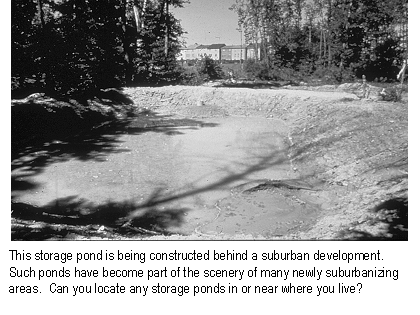
Helping Water Behave Naturally
Many new urbanization projects, such as housing developments or shopping malls, have storage ponds built in a corner, as part of the landscaping, or behind the main construction. The ponds store the water that runs off parking lots and paved areas. These ponds benefit the area by reducing the amount of water that streams need to carry after a rain event and allowing water to infiltrate into the ground and recharge groundwater supplies.
Searching for Drainage Systems
Pick a local shopping mall, grocery store, or professional park. Find out what drainage systems are used at the edge of the parking lots.
Location:
Type of system:
Where does the water go? How is it collected? Are there pipes that convey the water down into a storage pond?
What happens to the water in the storage pond if it rains excessively? Is there a spillway for the storage basin?
If all the water from the parking lot runs off into the storage basin, and only a small amount of the water is being infiltrated into the ground, what would happen to the groundwater in the area?
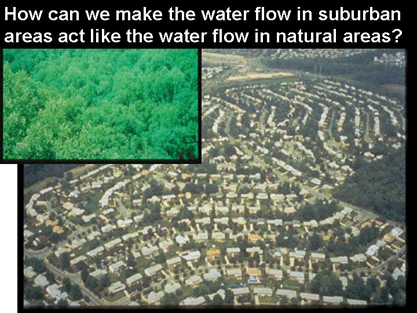
Low-Impact Development
Engineers are trying to come up with ways to make the water flow in urban and suburban areas act like the water flow in natural areas. To do this, they have come up with practices that help improve the interception and infiltration of water. Low-impact development is the phrase used to describe urban and suburban development that uses these practices.
Examples of Low-Impact Development Practices
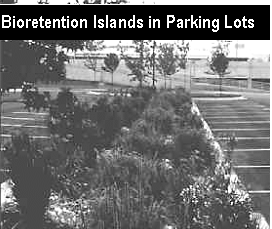
A bioretention filter consists of a grass buffer strip, a sand bed, a ponding area, an organic layer or mulch layer, planting soil, and plants such as leafy shrubs. These filters look like beds of shrubbery and can be placed as islands on parking lots. They use soils and woody and leafy plants to remove pollutants from storm water runoff. Runoff from large paved surfaces like parking lots passes first over or through a sand bed, which slows the speed of the flowing water. It also distributes the water evenly along the length of the ponding area. The ponding area is made of soil, but it slopes into the center. Water gradually infiltrates the bioretention area, evaporates, and is taken up by the plants.
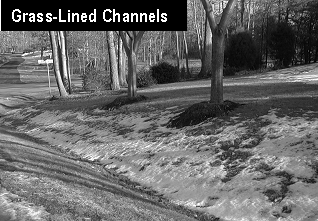
Natural drainage courses can be maintained by using grass-lined channels as much as possible instead of concrete canals, pipes, and gutters.
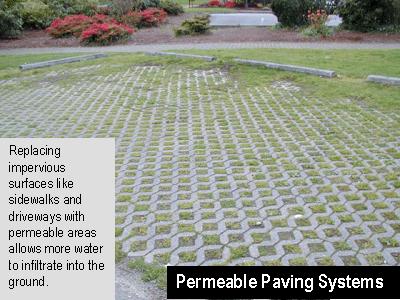
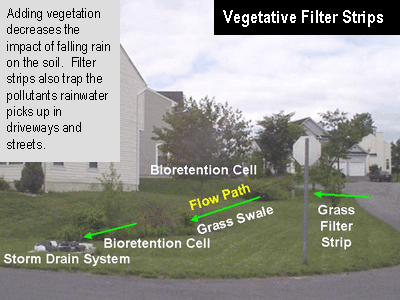
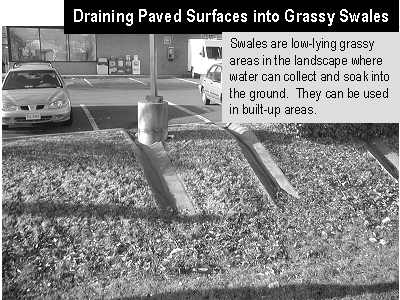
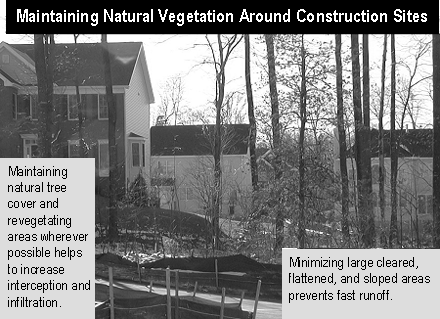
Redesign Your Schoolyard for Low-Impact Development
1. Draw a sketch of your school and its property from a bird's eye view (top down). In the sketch, label the areas that are impervious, that are somewhat impervious, and that allow water infiltration. (If you completed the Infiltration at Your School section of Exercise I, you will already have a sketch of your school.)
2. In a second sketch, use some low-impact development practices to redesign your schoolyard. Label all the low-impact development practices you used to help infiltrate runoff from impervious surfaces around your school.
Redesign Your Neighborhood for Low-Impact Development
Look at the areas around streets in your neighborhood. Are there are strips of open spaces or areas that are not directly used as roadway, bike path, or walking pavement/trail? What is the land cover of these surfaces?
1. Draw a cross section of your street here. Try to give a to-scale depiction of the diameter of cul-de-sacs, the width of your street, and the width of sidewalks and parking areas.
2. Now draw a cross section of your street in which you have implemented some of the practices that will increase the infiltration, detention, and retention of water that comes down in a storm. Also, think about ways to delay the conveyance time (the time it takes for rainwater to enter streams) and try to incorporate those.
Middle Schools | Streams in the City | Exercises: I | II | III | IV | Top
